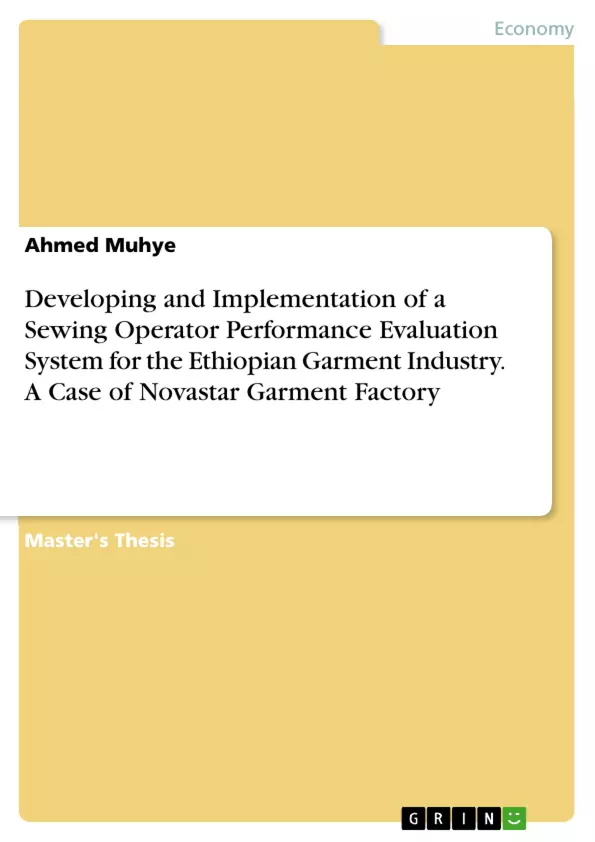Ethiopian garment manufacturers need to improve their manufacturing performance to be competitive in local as well as international markets. The garments need to be of high-quality meeting in international standard, low cost and on-time delivery simultaneously. Some of the Ethiopian garment manufacturer problems like lack of skill monitoring system for employee skill evaluation methods, high levels of competition, low level of production efficiency, produce low-quality product, does not meet daily target, inadequate training, dissatisfaction of sewing operators and absenteeism, are some of the existing problems. Therefore, for such problems focusing on performance of sewing labor is essential.
The focus is on raising the production efficiency and multi-skill development in the sewing production line through a skill matrix tool. The workers skill is analyzed on different jobs and based upon his/her performance on a job, a grade is given. This grade defines the level of performance an operator can achieve on that specific job.
This study aims to find out the skill gaps of each individual sewing operators and categorization of the workers based on their skill levels and builds up the labor performance monitoring system. The data collection method for this study was both primary and secondary data sources, and for the selection of sample size random sampling technique is used. The categorization is based upon the well-established attributes from literature and relevant websites and done in two ways: Skills on the operation (types and number of operations) and Skills on the machine (types and number of machines).
The study will initiate the management to know the performance of their employees and their skill gap, so that employees having better abilities may be rewarded and the wrong selection and placement may be reduced or avoided.
Inhaltsverzeichnis (Table of Contents)
- CHAPTER ONE INTRODUCTION...
- 1.1 Background.
- 1.2 Background of Ethiopian garment enterprises
- 1.3 Problem Statement.
- 1.4 Research purpose and objectives .......
- 1.4.1 Research purpose
- 1.5 Research objectives.
- 1.6 Justifications.........
- 1.7 Benefit and Beneficiary
- 1.7.1 Improved staff and team performance..
- 1.7.2 Benefits for organizations ....
- CHAPTER TWO......
LITERATURE REVIEW..\li>
- 2.1 Skills Management..
- 2.2 Workers skill level and attributes.......
- 2.3 Grade system for sewing machine operators.
- 2.4 Sewing machine operator skill level grading.
- 2.5 Grading based on efficiency of sewing machine operator.....
Zielsetzung und Themenschwerpunkte (Objectives and Key Themes)
This thesis aims to investigate the skill gaps of sewing operators in the Ethiopian garment industry and develop a performance evaluation system for them. The research focuses on the Novastar Garment Factory, examining how a skill matrix tool can be implemented to enhance production efficiency and multi-skill development within the sewing production line.
- Skill gap analysis of sewing operators
- Development of a performance evaluation system
- Implementation of a skill matrix tool
- Enhanced production efficiency and multi-skill development
- Improving the overall performance of the sewing production line
Zusammenfassung der Kapitel (Chapter Summaries)
- Chapter One provides an introduction to the study, outlining the background of the Ethiopian garment industry, the problem statement, research purpose and objectives, justifications, and benefits for organizations.
- Chapter Two delves into the relevant literature, examining skills management, worker skill levels and attributes, grade systems for sewing machine operators, sewing machine operator skill level grading, and grading based on the efficiency of sewing machine operators.
Schlüsselwörter (Keywords)
The study focuses on the Ethiopian garment industry, sewing operator performance evaluation, skill gaps, skill matrix tool, production efficiency, multi-skill development, and the Novastar Garment Factory.
- Citation du texte
- Ahmed Muhye (Auteur), 2021, Developing and Implementation of a Sewing Operator Performance Evaluation System for the Ethiopian Garment Industry. A Case of Novastar Garment Factory, Munich, GRIN Verlag, https://www.grin.com/document/1034372



